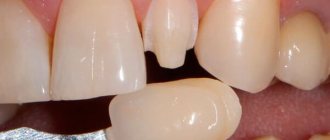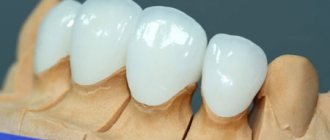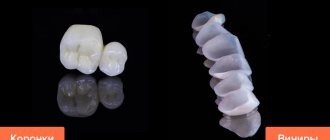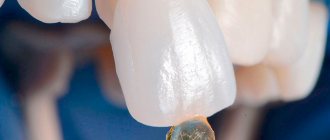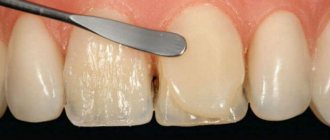From this article you will learn:
- what are veneers in dentistry,
- before and after photos, patient reviews,
- veneers – price for 1 tooth in Moscow (for 2021).
Veneers are microprostheses made of ceramic or composite filling material (in the form of thin plates) that cover the front surface of the teeth. The thickness of standard ceramic veneers starts from 0.6 mm, respectively, and the front surface of the tooth must be ground to the same depth (Fig. 1-3). However, in dentistry there are also so-called “thin veneers” - they are made from Emax glass ceramics. They have a thickness of 0.3-0.4 mm, which in some cases makes it possible to do without tooth preparation.
To complete the picture, it should be noted that there are also so-called ultra-thin veneers for the front teeth, which are produced by DenMat under the brand Lumineers® (Lumineers). The advertisement states that their thickness is only 0.2 mm, which is guaranteed to allow you to avoid grinding off the surface layer of tooth enamel. But this is not entirely true, and the original manufacturer's instructions already clearly indicate that the thickness of the lumineers will be from 0.3 to 0.7 mm (i.e. they will not be thinner than Emax).
What are dental veneers: photo
Correcting teeth with veneers allows you to improve their color and shape, allows you to change the inclination and position in the dentition, and also makes it possible to eliminate wide interdental spaces. Veneers are either “direct” (composite) or “indirect” (orthopedic). Composite veneers are made by dentists from ordinary composite filling material. They cost much less, and their aesthetics and service life are noticeably more modest - compared to higher quality indirect ceramic veneers.
In turn, orthopedic indirect veneers are made in a dental laboratory - mainly from various types of ceramics. The most common types of ceramics used to make veneers are porcelain, lithium disilicate, or zirconium dioxide. It is for such ceramic veneers that patient reviews will be as positive as possible, because... they really allow you to achieve excellent dental aesthetics (which can be seen in Hollywood stars). How much does it cost to install ceramic veneers? Read below.
Important: but patients are faced not only with the problem of choosing between ceramic and composite veneers (here it all comes down to budget). It becomes more difficult when the patient learns that ceramic veneers can be made not only from different types of ceramics, but there are also different technologies for their manufacture - the layer-by-layer ceramic application method, injection molding technique or CAD/CAM technology. And this also affects aesthetics and their service life.
Veneers for front teeth - indications for use
Veneers cannot be made on all teeth, but only on the 10 upper front teeth, as well as the 8 lower front teeth. These limitations are associated with too high a chewing load in the area of large chewing teeth. Veneers on the front teeth can correct:
- chipping of the cutting edge (Fig. 4),
- unattractive tooth color that cannot be improved by chemical whitening (Fig. 5),
- the shape of the teeth is not beautiful enough,
- spaces between teeth (Fig. 6),
- moderate crooked teeth that you want to correct without orthodontic intervention.
Ceramic veneers: before and after photos
What are ultranir?
Ultraneers are an innovative achievement in the field of modern dentistry. They are ultra-thin overlays that reliably protect the surface of the teeth, and also improve their shade and shape.
The production of such plates is carried out in laboratory conditions, using IPS e.max glass ceramics. The development of this material was carried out in Germany. At the moment, it is the safest material for the human body, which, moreover, has unsurpassed strength, uniformity and a long service life. It is obtained by pressing under high pressure.
How much does it cost to install veneers - price in Moscow
If you want to get what is called a Hollywood smile, you only need ceramic veneers, which will be made by an orthopedic dentist and dental technician of the highest qualifications, and from very high-quality ceramic mass. For such dental veneers, the cost in economy class clinics will start from 16,000 rubles, and in mid-price clinics - from 21,000 rubles (for 1 unit).
Of course, there is a much cheaper alternative in the form of composite veneers, which are made from a composite filling material directly in the patient’s mouth, in just 1 visit. The price for composite veneers for front teeth will be on average about 7000-9000 rubles (for 1 unit), and their minimum price in Moscow is from 4500 rubles. As for ceramic veneers, the price will depend on the type of ceramics used...
Ceramic veneers: cost for 2021
- from feldspathic ceramics (porcelain) – from 16,000 rubles.
- made of glass ceramics E.max PRESS – from RUB 21,000.
- from glass ceramics E.max CAD – from RUB 26,000.
- from zirconium dioxide - about 30,000 rubles.
Important: above we indicated how much dental veneers cost in Moscow - specifically in clinics in the mid-price segment. In different clinics there is a very wide range in prices for veneers, even made from the same materials. For example, the average price for 1 veneer from E.max PRESS should be about 21,000 rubles. However, in economy class clinics it can be only 16,000 rubles, and in others it can even reach 50,000 rubles.
When discussing the price with your doctor, it will be important to clarify whether they have a discount for the amount of work (if you do veneers on several teeth at once). When using veneers for 4-6 teeth, you can usually get a discount of up to 10-15%. We will immediately warn you that you should not look for clinics with the lowest prices. The latter will guarantee that your veneers will be done by an orthopedic dentist and a dental technician - not of the highest qualifications.
Feldspar ceramic veneers −
Dental feldspathic ceramics are also called porcelain. Porcelain was the first material from which veneers were generally made. It allows you to perfectly imitate the optical properties of real tooth enamel - its color and translucency. Porcelain veneers have very good aesthetics - no worse even in comparison with glass-ceramic veneers E.max (24stoma.ru).
Porcelain veneers: before and after photos
Porcelain veneers can be made using three different methods. Firstly, using the method of layer-by-layer application of porcelain mass, which implies that the ceramic mass is applied in layers and also baked in layers at high temperature. Secondly, by injection molding under conditions of high temperature and pressure (this method is preferable to the first, since the veneers will be much stronger).
Thirdly, there is feldspathic ceramics in the form of blocks, which are used for the manufacture of ceramic veneers/crowns using the milling method using a CEREC machine (CAD/CAM technology). An example of such material is “Vita Mark 2” Zahnfabrik, made in Germany.
Porcelain veneers – pros and cons, price
The main advantages are stunning aesthetics and affordable cost. The price for porcelain dental veneers in Moscow and St. Petersburg will be very affordable. For example, in economy class clinics it can start from only 12,000 rubles, and in mid-price clinics it will be about 16,000 rubles. But unfortunately, porcelain veneers also have some minor disadvantages...
For example, the flexural strength of porcelain layered veneers is only 50-75 MPa, which means there is a greater risk of porcelain chipping. When producing porcelain veneers by pressing or using CAD/CAM technology, the bending strength will be about 150 MPa. This is generally sufficient if you have a good bite and will not chew on anything hard. For comparison, veneers made from E.max have a bending strength of 370-400 MPa, but the price is 1.5-2 times higher.
Porcelain veneers before and after (video 1) –
In the video below you can see how amazing veneers on the front teeth made of feldspathic ceramics (porcelain) can look, which are indistinguishable from the most beautiful real teeth.
Installation of onlays: stages of treatment
Installing onlays on teeth takes from 2-3 days to a month, depending on the type of microprosthesis chosen. In general, the patient will undergo the following treatment:
First visit:
- preparation of teeth: professional cleaning to remove plaque, tartar, treatment of caries or other diseases, if any,
- removing part of the enamel: this step is relevant only when installing veneers or ultraneers,
- taking impressions that will be used to create custom prostheses.
About 2-4 days pass between the first and second visit - this is the time it takes to make the dentures in the laboratory. However, if you choose lumineers, then about a month will pass between the stages, because the designs are developed abroad and sent to the Russian clinic.
Second visit:
- installation of prostheses: after the structures are created in the laboratory, they are tried on and, if necessary, adjusted. The surface of the teeth must be polished and treated with abrasive. Next, glue-cement is applied and the linings are tightly glued to the surface of the teeth.
Glass ceramic veneers E.max –
As we said above, ceramic materials for making veneers include not only porcelain and zirconium dioxide, but also glass ceramics E.max (). Today, this is the best option for making veneers, which combines the stunning aesthetics of porcelain veneers and high strength.
E.max is not just ceramics, it is glass ceramics. This material consists of translucent lithium disilicate crystals (i.e., it has a glass matrix, which in its optical properties is as similar as possible to real tooth enamel). In the hands of a qualified dental technician, E.max glass ceramics will give you the Hollywood smile of famous actors and music performers.
E.max veneers for front teeth: before and after photos
Emax veneers can be made from 2 varieties of this material - either from the “E.max PRESS” material or from the “E.max CAD” material. If you want to put veneers on your teeth, the price of E.max can vary greatly in different clinics, not only because of different pricing policies, but also because of the use of different E.max materials. How these materials differ – read below.
- Veneers from E.max PRESS (Fig. 10-11) – E.max PRESS glass ceramics are designed for the production of veneers/crowns using injection molding, which makes them very strong (flexural strength 400 MPa).
From this material you can make not only standard veneers with a thickness of 0.6 mm, but also so-called “thin veneers” - only 0.3-0.4 mm thick. Thin veneers require either minimal grinding of the enamel on the front surface of the tooth, or sometimes they can be installed without disturbing the enamel at all. Moreover, the small thickness does not affect their strength. A special feature of E.max PRESS is a wide range of color shades and a choice of the degree of transparency of the material, which allows the dental technician to make ideal veneers from this material.
- Veneers from E.max CAD (Fig. 12) – E.max CAD material is produced in the form of blocks intended for milling veneers/crowns on a CEREC program-controlled machine.
This technology is called CAD/CAM. By the way, exactly the same manufacturing method is used for zirconium dioxide veneers. The strength of veneers made from E.max CAD is about 360 MPa, which is also very good. Veneers made from E.max CAD are more expensive simply because their production requires very expensive equipment. As for aesthetics, E.max PRESS is a little better. This is due to the fact that E.max CAD has fewer options for selecting color shades and degrees of transparency of the material. As a result, there is a higher risk of mismatch between the veneers and the teeth adjacent to them - in color and transparency. And, by the way, thin veneers cannot be made from this material.
Important: we already wrote above how much veneers for the front teeth made of E.max glass ceramics cost. This is on average from 21,000 rubles for 1 veneer from E.max PRESS, and from 26,000 rubles from E.max CAD. Both materials are good, but you can safely choose the less expensive E.max pressed ceramic without worrying about its quality being inferior.
Trying on veneers from E.max + reviews (videos 2 and 3) –
Zirconium dioxide veneers –
Zirconium veneers are the most durable. If the veneers are made of opaque zirconium dioxide, their bending strength will be about 900 MPa, and if they are made of translucent zirconium dioxide, they will be about 550 MPa (which is also very high). This certainly eliminates the risk of porcelain chipping if the veneers are made from monolithic zirconium dioxide rather than by applying porcelain to a milled zirconium frame. But when it comes to aesthetics, zirconium veneers are inferior to both feldspathic ceramics and E.max glass ceramics.
Zirconium veneers: before and after photos
Problems with aesthetics are related to the characteristics of the material. The fact is that most dental clinics purchase so-called “raw” “soft” zirconium dioxide (it has a low price). And because Since this material is soft, it allows the clinic to save a lot of money - also on the need to change cutters for milling zirconium blocks less often. The problem is that this cheap zirconia is bright white and lacks translucency, so veneers made from this material will not be very aesthetically pleasing.
Important: however, there are also more expensive zirconia blocks - pre-colored / translucent (the latter thanks to the addition of yttrium), which allow you to make veneers of almost the same quality as veneers made from E.max PRESS pressed ceramic. Such materials include -
- the best option is the Katana® UTML material (Japan) - zirconium veneers from this material are practically not inferior to veneers from E.max PRESS,
- slightly more modest options are Katana® STML (Japan) or Prettau® Anterior (Germany) materials.
How much does it cost to install zirconium veneers?
The cost of veneers for front teeth made of good quality zirconium dioxide should be about 30,000 rubles (for 1 unit), plus or minus several thousand rubles. However, when using so-called “raw” zirconium dioxide, the minimum price we fixed in Moscow was 12,000 rubles, which is due to the low cost of such material.
Zirconium veneers on teeth (video 3) –
In the video above you can see that initially there are old, but still good fillings on the upper central incisors. Obviously, the doctor who posted this video is proud of the result, but let’s take a closer look at the manufactured veneers... It’s immediately clear that the so-called “body” of the veneers (in the middle third, as well as in the third closest to the gum) is too massive and absolutely opaque. And that is why these expensive zirconium veneers look more like cheap metal ceramics.
Secondly, the contrasting zone where the veneer transitions into the gum immediately catches your eye. And again, these look like cheap crowns. Therefore, we once again recommend that if you decide to make veneers from zirconium, then make them from a translucent material, for example, Katana® UTML (Japan). True, for this you will have to try hard, finding out exactly what they do in each clinic, and hope that you will not be deceived.
How to install veneers on teeth -
If you have already decided on the type of ceramic veneers, this does not mean that you will get the beautiful teeth you dreamed of.
Prosthetics with veneers consists of the work of 2 specialists. Firstly, an orthopedic dentist who will grind your teeth, take impressions and then fix the finished veneers on your teeth. And secondly, a dental technician, who, based on the impressions taken in the dental laboratory, will actually sculpt your veneers from ceramic mass. Important: preparing teeth for veneers requires great skill, but it is even more difficult to find a great dental technician who will give the veneers a beautiful shape and will be able to take into account all the nuances of the color and translucency of the tooth enamel (otherwise the veneers will look like cheap metal-ceramics). There are only a few such dental technicians. In order not to be disappointed, you can ask to make a diagnostic mock-up/template for future veneers (called a mock-up).
The doctor makes such a template from a temporary composite material directly on the patient’s teeth (even before the stage of grinding off the enamel). The purpose of the template is to show you what the shape of your veneers will be and to agree on it with you. If you like the shape of your future teeth, agree to treatment. If you don’t like the dental aesthetics on the diagnostic mock-up template, you should look for another clinic. Believe me, this will save you from disappointment and loss of money.
Thick and thin veneers: installation
Standard dental veneers usually have a thickness: circularly along the front front surface of the tooth - about 0.6 mm, and along the cutting edge - from 0.7 mm (Fig. 17). Accordingly, the front surface of the teeth and the cutting edge will be ground to such a depth (Fig. 18), otherwise the teeth will look too massive. Normally, the thickness of the enamel layer on the front surface of the tooth varies from 0.3 to 0.5 mm.
It is very important (if possible) not to grind off the entire layer of enamel, otherwise the veneer will be fixed to the softer and darker layer of dentin. Firstly, this will worsen the aesthetics, and secondly, veneers are least susceptible to chipping when they are fixed to the hardest possible base, i.e. to enamel. Unfortunately, when using veneers with a standard thickness of 0.5-0.6 mm, this is not always possible, but here the so-called “thin veneers” help us out.
Thin veneers (Fig. 17) - this version of veneers has a circular thickness of about 0.3, and along the cutting edge - 0.4 mm. Thin veneers are made from pressed glass ceramics E.max PRESS. As a result, the thickness of the grinding of the tooth enamel is sharply reduced, the veneers are glued to a strong base (enamel), and thanks to the adhesive type of fixation, they become one with the tooth enamel, not inferior in strength to veneers of standard thickness. In some cases, thin veneers make it possible to avoid grinding the enamel altogether.
Some companies call their thin veneers the term ultraneers. The term lumineers is also known - this is the proprietary name of an American manufacturer of thin veneers, which are produced in the form of ready-made sets. Lumineers are installed without grinding the teeth.
Installation of veneers: video
The first video is grinding teeth for veneers; the second is the fixation of finished ceramic veneers.
Ultranir service life
The uniqueness of the IPS e max ceramic material lies in its ability to withstand increased loads even with a small thickness of 0.3 mm. Moreover, such a metal-free plate is characterized by uniformity and the ability to maintain the original shade for 10 years or more. When done correctly, ultranir adheres tightly to the tooth surface, which guarantees long-term use and resistance to external influences. Taking into account the indicated indicators and the possibility of a professional approach, ultranir can have a service life of about 15 years .
In our dentistry, highly qualified specialists with impressive experience in the field of artistic dental restoration will work with you. They regularly take advanced training courses in the best foreign clinics and master the intricacies of working with innovative restoration materials. We also use modern equipment in our activities, which significantly improves the quality and accuracy of the procedures performed, and also guarantees a prolonged result.
Ceramic veneers: patient reviews
Patient reviews of ceramic veneers in most cases are enthusiastic, because they really can make you the owner of a Hollywood smile. But, this is only if your veneers are done by a truly highly qualified dental technician. In addition, it is very important that the clinic you go to has its own dental laboratory.
This will allow the prosthodontist and dental technician to make decisions together while standing at the chair, and the dental technician will then have the opportunity to look at you in the chair, allowing him to select the best color and translucency option for your veneers.
Advantages of ceramic veneers –
- Highest aesthetics.
- Complete color stability - they do not darken or fade over time, as happens with composite veneers.
- High reliability - service life is limited only by extreme circumstances, such as injury, and ranges from 12 to 25 years in most cases.
The only drawback of such veneers is their cost. But a natural question arises: how can veneers made from a thin layer of porcelain 0.3-0.5 mm thick be strong at all? There are not many clinical studies in the world on the strength of veneers and their service life. However, we tried to find them (you can see the results below).
- The results of the study (author - Smales, 2004) - the “survival rate” of veneers 7 years after their manufacture was: after 7 years, 86% of veneers made without overlapping the incisal edge functioned perfectly, and their owners had no complaints about them .
However, for veneers made with incisal overlap, the survival rate was 96%. This suggests that, firstly, ceramic veneers with an overlapping incisal edge are more reliable, and secondly, that after 7 years only 4% of patients had any problems and complaints about the manufactured veneers. In addition, if suddenly the veneer falls out over time, you can bring it to the dentist, and they will immediately reattach it to you.
- The results of a similar study (Leighton, 2007) - based on an assessment of 304 porcelain veneers installed in one hundred patients showed: after 5-6 years, 96% of veneers were intact, after 10-11 years - 93%, after 12-13 years - 91% and 73% of veneers were intact even after 15-16 years.
As we see from these studies, in some patients the veneers periodically failed. The main reasons that led to the unsuitability of veneers were chips of ceramics, cracks, and loss of veneers. As we see: all this happened, but in a small percentage of cases. In addition, if the veneer falls out, it can easily be reinstalled on the tooth. But a crack or chip in the ceramic will require replacement of the veneer.
In addition, veneers often became unusable due to the patients themselves. Firstly, poor hygiene led to the appearance of caries near the veneer and subsequent tooth destruction. Secondly, injury to teeth/veneers as a result of impact, gnawing on nuts and seeds. Thirdly, sharp temperature changes (hot coffee + ice cream) led to cracks in veneers.
Important: taking into account the results of these studies, one must keep in mind that over the past 10-15 years since the research, new types of ceramic materials and manufacturing technologies have appeared, which have made it possible to further increase the strength and service life of ceramic veneers.
Reasons for using dental veneers
Back in the 30s of the twentieth century, dentists from the USA and Western Europe began to think about restoring the aesthetic appeal of the dentition. Before this, the priority remained simple restoration (filling). Progress has not stood still and over the past time, dentists have managed to develop unique technologies.
Thanks to them, today everyone can become the owner of a Hollywood smile. Regardless of the difference between veneers and lumineers and other prostheses, onlays are used in the following cases:
- Darkening of the enamel, yellowness, when conventional whitening methods are powerless;
- Interdental gaps - trema and diastema;
- Old fillings with distinct outlines;
- Slight curvature of teeth;
- Chips, cracks, other enamel defects;
- Weak surface of the teeth, when sweet, hot and cold foods cause pain and discomfort;
- Just a desire to have well-groomed teeth and a beautiful smile.
In parallel, there are circumstances that prevent the use of overlays:
- Weak enamel when preliminary grinding of the tooth is necessary;
- Severe forms of malocclusion;
- Bruxism or involuntary squeezing of teeth, leading to deformation and peeling of the veneers;
- Gum diseases.
In each specific case, the possibility or impossibility of installing a microprosthesis is determined by a specialist. A wide range of materials speaks in favor of clients, allowing them to choose the right solution in difficult situations.
Veneers made from composite filling material –
Those who have made veneers from composites know that they have significant disadvantages.
You will find detailed information about the level of patient satisfaction with such veneers in the “reviews/service life” section. As we have already said, composite veneers in Russia in 95% of cases are made by dental therapists directly in the patient’s mouth, but there is also a technology for their manufacture in a dental laboratory. In fact, such a veneer is a regular filling that occupies the entire front part of the tooth. Composite veneers on the 6 upper front teeth –
The aesthetics of composite veneers are very far from the aesthetics of ceramic veneers. If you take a closer look at the before and after photos (posted just above), you will see that veneers made from composite do not have the translucency that natural tooth enamel has, and they also have a slightly unnatural milky color. However, such veneers also have undeniable advantages.
Firstly, the cost of composite veneers is at least 2-4 times lower than ceramic ones. Secondly, they can be done in just 1 visit. True, they have much more disadvantages and, of course, if you are very demanding in terms of aesthetics and reliability, then veneers made from a composite filling material are unlikely to suit you (read about the disadvantages of such veneers at the link above).
Reviews of composite veneers –
Composite veneers - service life is approximately 2-3 years or 3-4 (if you're lucky). We must remember that such “veneers” need periodic polishing, but in any case, over time they will darken and fade, and after 4-5 years they will look like this -
Study (by Wakiaga, 2004) - assessed patient satisfaction with composite veneers. It was conducted based on a survey of 200 people over a 2.5-year after they received composite veneers. The satisfaction rate was only 67%, in contrast to, for example, satisfaction with ceramic veneers (93%).
However, for the latest study it is necessary to make allowances for Russian reality. As we have already said: the quality of manufacturing composite veneers abroad is much higher, so you should not create any illusions that cheaper composite veneers will look like expensive ceramic ones.
How is the installation carried out?
In order to install ultraneers at MedicaStom, it is enough to make only 3 visits to the doctor.
1st visit
Taking an impression
30 minutes
2nd visit (after 3 days)
Transferring the wax model into the oral cavity, color selection
60 minutes
3rd visit (after 5-7 days)
Fixing ultranir
Luxurious smile!
90 minutes
Make an appointment or call us right now, and in just 10 days you will be the owner of a dazzling smile! There will be no difficulties with installation.
Veneers: contraindications
When you can’t put veneers on your teeth - reviews from dentists indicate that breakage of veneers (which will require their replacement, with associated costs) is most likely in the presence of the following conditions:
- increased tooth wear of grade 2 and higher,
- absence of chewing teeth (sixth, seventh),
- extreme lifestyle (boxing and other contact sports),
- presence of bruxism,
- bad habits - biting threads or nails, opening beer with teeth,
- You cannot install veneers on teeth treated with resorcinol-formalin,
- severe destruction of the lingual (inner) surface of the tooth,
- the presence of a medium or large filling on the lingual surface of the tooth,
- incorrect bite (direct or reverse).
In what cases are ultraneers installed?
Despite the increased attractiveness of microprostheses for modern residents, they cannot solve complex dental problems. As a rule, ultraneers are installed only if there are minor deficiencies:
- Cosmetic enamel defects (chips and cracks);
- Hereditary or acquired darkening of shade;
- Slight curvature of individual areas;
- The presence of minor gaps between dental units.
Before installing ultraneers in Moscow, a specialist must carry out a thorough inspection and identify possible limitations. These include:
- Malocclusion;
- Unconscious closing of the jaws;
- Excessive tooth wear;
- The presence of any infectious processes in the body, diseases in the cardiovascular system, psychological disorders, etc.);
- Inadequate oral care.
Veneers: pros and cons
Below we will give answers to questions that patients often ask when consulting an orthopedic dentist regarding the installation of veneers...
What is better - veneer or crown?
First of all, veneers can be done on any teeth, but with the exception of 6-7-8 chewing teeth. Secondly, they can only be done in the absence of contraindications, which we listed above in this article. If there is at least one contraindication from this list, it is advisable for you to opt for crowns. What to choose - veneers or crowns (in the absence of contraindications), then the best choice is definitely veneers.
For a veneer, the tooth is ground down mainly only from the front surface, which allows you to preserve not only more of the tooth’s own tissues, but also leave the tooth alive. This will certainly increase its service life. Thin veneers require grinding down the enamel by only 0.3 mm, and the tooth for the crown is ground down on all sides by an average of 1.5-2 mm (which makes it look like a stump).
A tooth ground for a metal-ceramic crown –
What is better – veneers or restoration?
Porcelain veneers have a unique property - they are able to completely imitate your own tooth tissue. This happens because both tooth enamel and porcelain are equally translucent and reflect light equally. In healthy teeth, light rays pass through the tooth enamel and are reflected from the denser and darker dentin underlying the enamel.
After reflection, the light rushes back, which gives the enamel a shiny, somewhat glassy appearance. The same thing happens with porcelain veneers: light passing through them is reflected from the darker cement and rushes back. In addition, with the help of special pigments, you can give porcelain any shades that will imitate the color and transparency of neighboring healthy teeth.
But the light-polymer/composite filling material, which is used for restorations, does not have the same characteristics of light transmission and translucency. Therefore, the aesthetics of filled front teeth are very far from ideal, unless, of course, you are really picky about aesthetics. Take a closer look at the restored teeth - they are always grayer and duller than healthy teeth (Fig. 26).
Restorations are not only inferior in aesthetics initially, but they also have the property of darkening over time, and therefore after a few years they usually require replacement. In addition, very often a dark line appears at the tooth/filling border over time (due to the penetration of pigments), which already worsens the aesthetics. But porcelain veneers will not change their color at all even after 20 years.
Installation of ultranir. Just two visits to the dentist
Ultraneers are installed quickly. In order to achieve your goal and get a perfect snow-white smile, just two visits to an orthopedic dentist are enough (usually). At the first visit, the doctor will carefully examine the appearance of the teeth, their relationship, and determine the patient’s bite. All this allows him to verify the possibility of using the chosen method and the absence of contraindications. Next, the doctor will make impressions and determine the color of the patient’s teeth, their level of transparency and select the shade of ultraneers, possibly several shades, this allows them to be made as similar as possible to their own teeth.
The impressions are sent to the laboratory where ultraneers are made individually for each patient.
At the second visit, the dentist fixes the ultraneers with composite glue.
